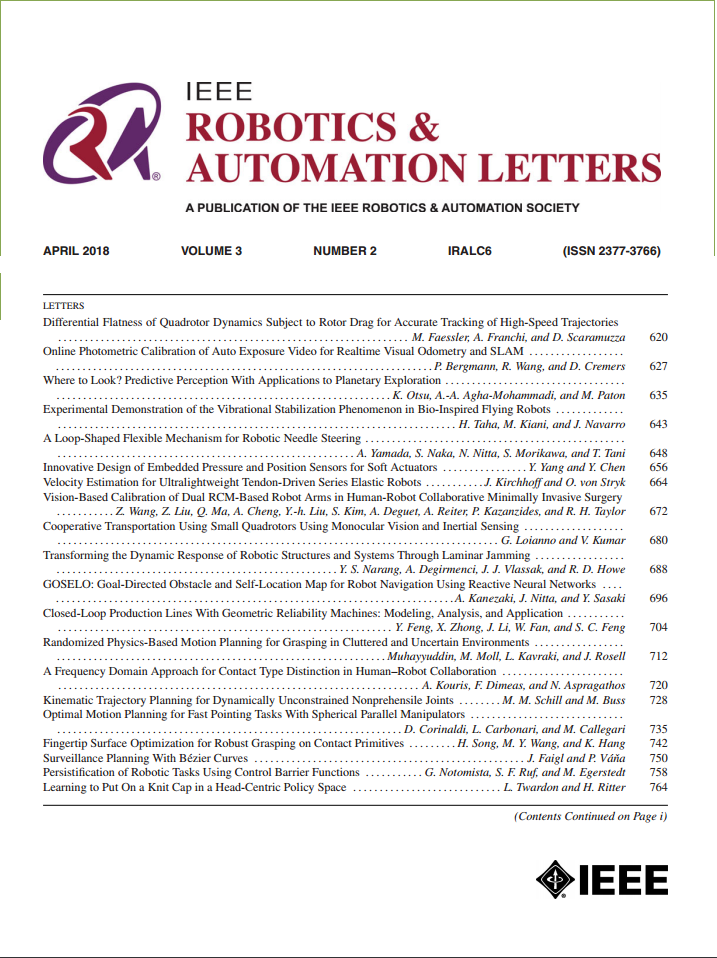Harnessing the Power of Vibration Motors to Develop Miniature Untethered Robotic Fishes
IF 4.6
2区 计算机科学
Q2 ROBOTICS
引用次数: 0
Abstract
Miniature underwater robots play a crucial role in the exploration and development of marine resources, particularly in confined spaces and high-pressure deep-sea environments. This study presents the design, optimization, and performance of a miniature robotic fish, powered by the oscillation of bio-inspired fins. These fins feature a rigid-flexible hybrid structure and use an eccentric rotating mass (ERM) vibration motor as the excitation source to generate high-frequency unidirectional oscillations that induce acoustic streaming for propulsion. The drive mechanism, powered by miniature ERM vibration motors, eliminates the need for complex mechanical drive systems, enabling complete isolation of the entire drive system from the external environment and facilitating the miniaturization of the robotic fish. A compact, untethered robotic fish, measuring 85 × 60 × 45 mm3, is equipped with three bio-inspired fins located at the pectoral and caudal positions. Experimental results demonstrate that the robotic fish achieves a maximum forward swimming speed of 1.36 body lengths (BL) per second powered by all fins and minimum turning radius of 0.6 BL when powered by a single fin. In addition, the robotic fish is able to swim upstream in turbulent flow, and its autonomous version can navigate complex, obstacle-filled environments. These results underscore the significance of employing the ERM vibration motor in advancing the development of highly maneuverable, miniature untethered underwater robots for various marine exploration tasks.利用振动马达的力量开发微型无系绳机器鱼
微型水下机器人在海洋资源的勘探和开发中发挥着至关重要的作用,特别是在密闭空间和高压深海环境中。本研究介绍了一种微型机器鱼的设计、优化和性能,该机器鱼由仿生鳍的振荡提供动力。这些鳍片采用刚柔混合结构,并使用偏心旋转质量(ERM)振动电机作为激励源,产生高频单向振荡,诱导声流推进。驱动机构由微型ERM振动电机提供动力,消除了对复杂机械驱动系统的需求,使整个驱动系统与外部环境完全隔离,促进了机器鱼的小型化。这是一种紧凑的无系绳机器鱼,尺寸为85 × 60 × 45毫米,在胸鳍和尾鳍处配备了三个仿生鳍。实验结果表明,在全鳍驱动下,机器鱼的最大向前游动速度为1.36体长/秒,单鳍驱动时,机器鱼的最小转弯半径为0.6 BL /秒。此外,机器鱼能够在湍流中逆流而上,其自主版本可以在复杂的、充满障碍物的环境中航行。这些结果强调了采用ERM振动电机在推进用于各种海洋探测任务的高机动性、微型无系绳水下机器人的开发中的重要意义。
本文章由计算机程序翻译,如有差异,请以英文原文为准。
求助全文
约1分钟内获得全文
求助全文
来源期刊

IEEE Robotics and Automation Letters
Computer Science-Computer Science Applications
CiteScore
9.60
自引率
15.40%
发文量
1428
期刊介绍:
The scope of this journal is to publish peer-reviewed articles that provide a timely and concise account of innovative research ideas and application results, reporting significant theoretical findings and application case studies in areas of robotics and automation.
 求助内容:
求助内容: 应助结果提醒方式:
应助结果提醒方式:


